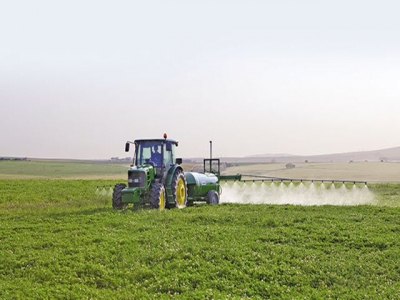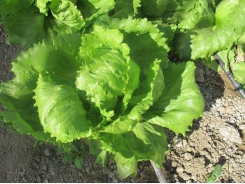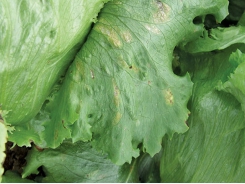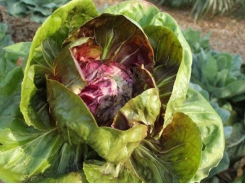Integrated pest management system

The international farming community must contend with numerous pest and disease threats to their crops, as the pressure of an increasing global population mounts. According to Schalk van der Merwe, technical manager for the SA subsidiary of ADAMA Agricultural Solutions, integrated pest management is the only sustainable solution to this problem.
More than 80 million people are born every year, and pressure on international agriculture to provide the planet’s rapidly growing population with the required food, fibre and other materials is increasing drastically. With this the importance of using integrated pest management systems is also increasing.
To feed the world’s population, farmers will have to produce more food over the next 40 years than was produced over the past 10 000 years, according to the UN’s Environment Programme. Unfortunately, due to misguided and unsustainable human activities, an area of arable land the size of a soccer field is currently being lost every second.
Why we need integrated pest management systems
It is thus essential, says Schalk van der Merwe, technical manager for the South African subsidiary of ADAMA Agricultural Solutions, that agriculture implement integrated pest management (IPM) as a means to maximise productivity.
“Integrated pest management is a strategy that draws on a range of management tools, with the goal of using the least ecologically disruptive techniques to manage pests within economically acceptable levels. It’s by no means a pie-in-the-sky concept,” he explains.
Key pillars of IPM include:
- The gaining of detailed knowledge of pest threats and the various options available to manage them;
- Preventing the establishment of these pests;
- Careful monitoring of existing and potential pest threats;
- Implementing interventions against any pests that emerge;
- Evaluating the effectiveness of pest threat management to improve on it where necessary.
According to Van der Merwe, on a practical level, one of the components of integrated pest management includes the production of crop cultivars bred or genetically modified to have increased resistance to pests and diseases in a particular farming environment. Other components are monitoring crops to see what pests and diseases are present and how the crops are coping with them, and researching the best cultural, biological and chemical controls and using each at the appropriate time.
Monitoring is the first crucial step for effective integrated pest management in any cropping enterprise, he says. It should be implemented systematically on an ongoing basis, down to the same number of representative plant samples within specified blocks, so that data collected for generations of crops can be compared to determine if an intergrated pest mangaement strategy is working, or if it needs improving.
“While visual monitoring for pests and diseases and the diligent recording of the observations can be sufficient, the accuracy of the comparative data can be enhanced by also using tools such as insect traps or weather models for disease occurrence, to measure pest and disease pressures and the effectiveness of the integrated pest management programme at various stages in the life cycle. It’s also important to monitor pests and diseases present on the product at harvest, as this gives a good indication on where the IPM programme should be improved on.”
In addition, farmers should set thresholds for the nature and extent of pest and disease threats, and the damage they are causing.
These thresholds will vary from farmer to farmer, and depend on whether pests are primary or secondary. Such thresholds will indicate when to begin implementing successive stages and increasing intensities of integrated pest management measures.
Cultural control
Cultural control measures available for use in an integrated pest management system include crop seed or plant material certified as being tolerant of, or resistant to, particular pests and diseases.
Farmers also have the option of having this seed or plant material treated to offer added protection. The company offering this treatment must provide written certification of having carried out the requested action.
Mechanical weed control also forms part of cultural control measures. It is essential, however, that this procedure be carried out before weeds are mature enough to spread their seed. The intention is to reduce weed seed loads so that fewer weeds are found amongst subsequent crops. Organic and plastic mulches – whichever is more practical and cost-effective – can also be used as a cultural control for weeds.
“These mulches help to inhibit the germination and growth of weeds between crop rows. Farmers must, however, ensure that any organic mulch is weed-free so as to not introduce new weeds. It’s also essential that diseases, pests and weed seeds are not spread between crop lands or tunnels via the movement of plant materials, animals, people, equipment or machinery.”
Although this may seem a nuisance, Van der Merwe says it has been proved that implementing measures to reduce this spread can have a positive impact as part of an integrated pest management system. “Even immediately removing and burying or burning plants infected with pests and diseases can have positive results for the rest of a crop.”
Alternating crop types planted in a land or tunnel helps to break pest and disease cycles, provided the different crops are not hosts for the same pests or diseases. Effectiveness is enhanced by rotating crop cultivars with different planting and maturity dates.
Matching crops to areas on a farm best-suited to their production helps reduce stress on a growing crop; a stressed plant is significantly more susceptible to attacks.
An additional cultural control measure is to provide crops with the exact moisture and nutrients they require for an optimally functioning immune system. This requires that soil analysis, soil moisture measurement and leaf and fruit sampling, among others, are appropriately conducted to ensure correct knowledge of the needs of a crop for optimal health and production.
Biological control
Biological controls are available to reduce the need for, but never fully replace, chemical control. According to Van der Merwe, if biological control measures are positioned correctly in any integrated pest management programme, particularly in low pest and disease pressure situations, they can be of great help.
However, chemical control will become the only option in cases where pest and disease challenges are medium to high.
He stresses that farmers must do their homework before making a purchase. Many biological control products are available, and it is important to seek advice from knowledgeable and trustworthy sources on which of these products work best, and on how and when to use them in order to ensure optimal results.
“Many biological control products have highly targeted actions,” says Van der Merwe. “Therefore it’s often best that a variety is used simultaneously to give broad action against pests and diseases. However, be aware of ‘snake-oil’ products. They often promise a lot, but when they don’t work as promised they can end up costing the cropping enterprise a lot of money in failed harvests.
“It’s important for farmers to note that biological products claiming efficacy against pests or diseases need an ‘L’ number on the label. This indicates that the manufacturer submitted efficacy results to the Registrar of the Fertilisers, Farm Feeds, Agricultural Remedies and Stock Remedies Act 36 of 1947 in order to get the product registered.” When they are required, chemical controls of pests and diseases are often highly effective.
However, a crop farmer must also obtain expert and objective advice on which of these products to use, and when and how to use them for best effect. It is also important to remember that chemical products cannot change their properties to suit a farmer’s pest and disease management methods. Instead, a farmer needs to change his management methods to accommodate a product’s properties.
Read the instructions!
A farmer must read the product label and adhere to it. Failure to do so will more than likely, whether immediately or over time, exacerbate the problem at hand. It could also lead to serious health problems for humans, animals and the environment.
“The equipment used to apply chemical products must always be in optimal working condition, and must be calibrated exactly to the requirements indicated on the product label,” stresses Van der Merwe.
“Variation between spray nozzles must also be kept to below 6%. I have seen very poor application equipment on many farms. By using equipment like this, these farmers will not achieve the results they want from chemical products, and will end up losing far more money from reduced yields than the costs of repairing and maintaining their application equipment. Under- or overdosing with chemical products will increase the likelihood of pests and diseases developing resistance to these chemicals.”
The quality of the water into which chemical products are mixed also has a significant impact on effectiveness. The label of a reputable chemical control product will give step-by-step instructions on what water quality parameters to test for and how to treat the water to the required quality.
It will also indicate how to mix the product into the water. If a farmer is unsure of the correct method and procedure, he or she should contact the product agent for advice. If more than one chemical control product is being mixed into the same tank for simultaneous application, they must be compatible.
Comprehensive website
Van der Merwe recommends the Agri-Intel website (www.agri-intel.com), which he says is an invaluable tool. The website claims to provide users with accurate, up-to-date and easily accessible agrochemical information.
“This information is essential in the successful management of crop protection strategies and the risks related to the use of agrochemical products in the highly competitive local and international markets,” it states.
Registration is free. Once registered, a user has access to printable labels of all reputable chemical control products for weeds, pests and diseases, among others. The user can also use the website to develop the most effective chemical control programme for particular pests and diseases of particular crops. “Farmers should use resources like this to stay informed,” says Van der Merwe.
Có thể bạn quan tâm
Phần mềm

Phối trộn thức ăn chăn nuôi

Pha dung dịch thủy canh

Định mức cho tôm ăn

Phối trộn phân bón NPK

Xác định tỷ lệ tôm sống

Chuyển đổi đơn vị phân bón

Xác định công suất sục khí

Chuyển đổi đơn vị tôm

Tính diện tích nhà kính

Tính thể tích ao hồ




 Physiological disorders in cabbage
Physiological disorders in cabbage  Bacterial diseases of lettuce
Bacterial diseases of lettuce